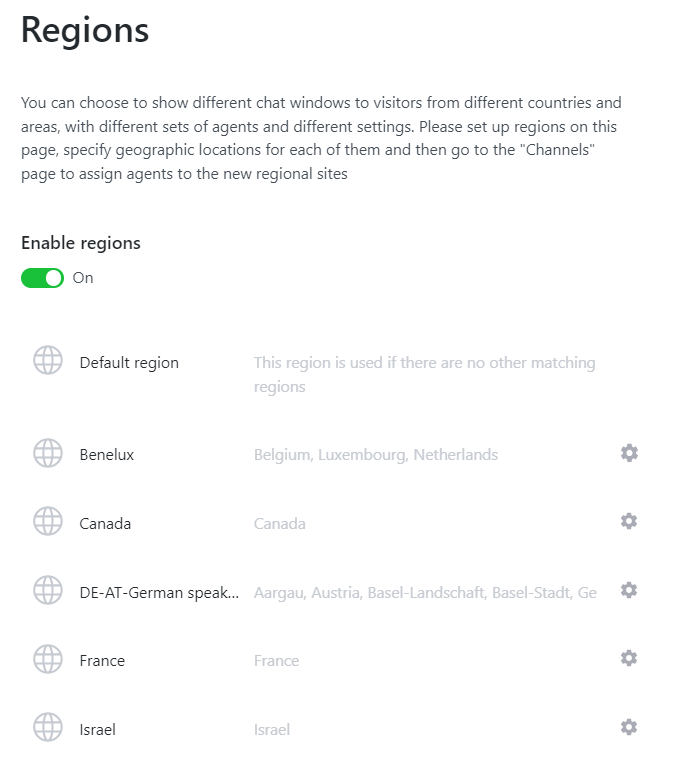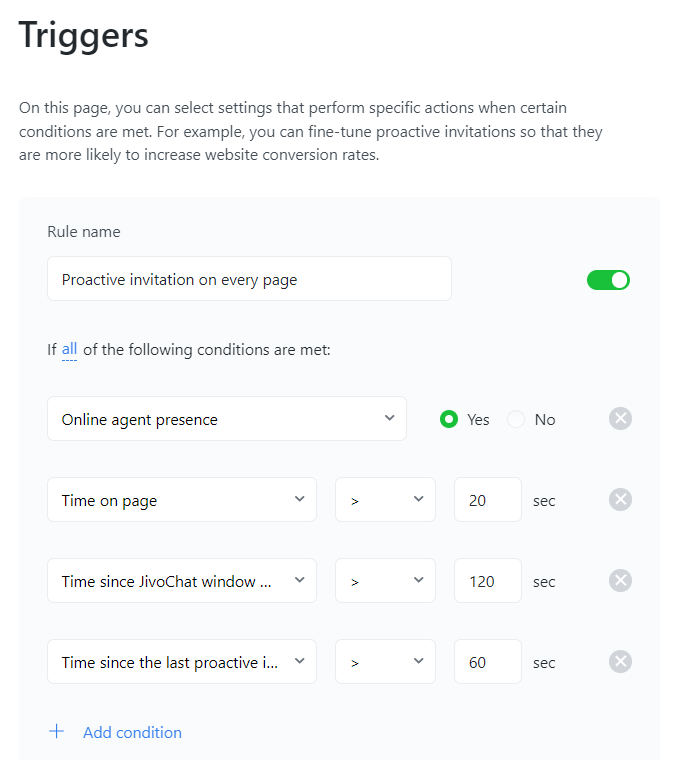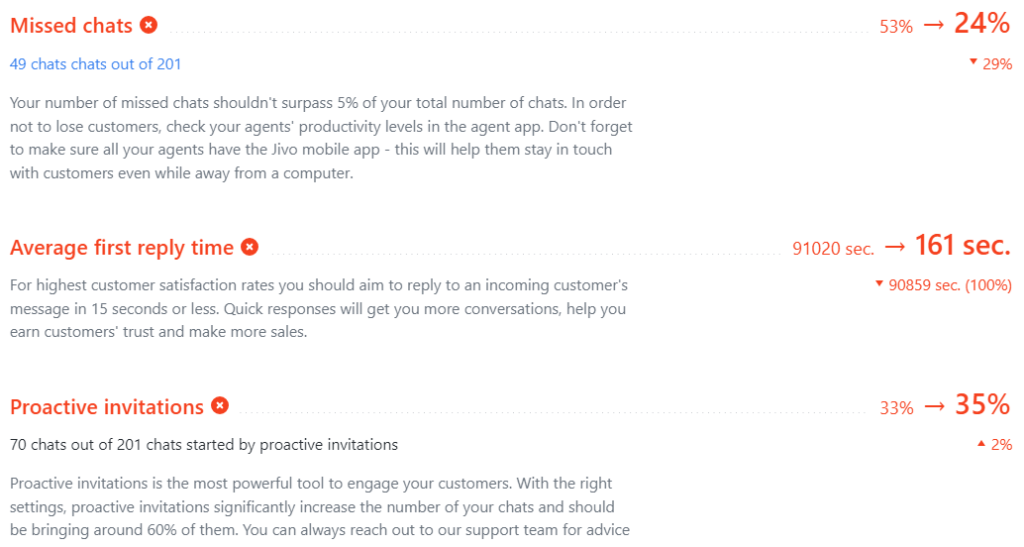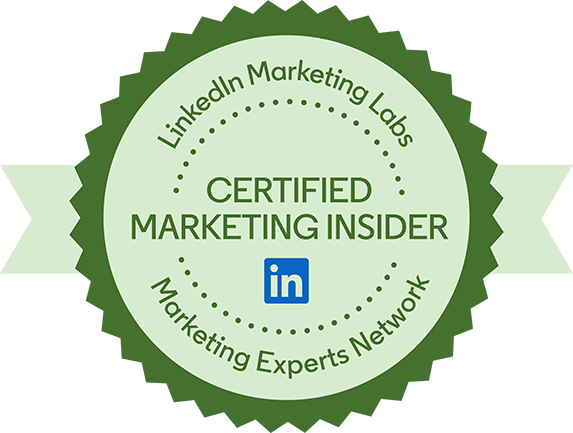Lead Generation and Online Live Chats: Tips & Best Practices for B2B & Tech
Date : September 12, 2024 By
Contents
- 1 Simplifying Live Chat Lead Generation
- 2 Why Don’t All Companies Use Live Chats for Lead Generation?
- 3 The Impact of Live Chat on Lead Generation
- 4 How Does Live Chat Benefit Lead Generation?
- 5 Key Strategies for Live Chat Lead Generation
- 6 Implementing Live Chat for Lead Generation: Step-by-Step Guide
- 7 Analyzing and Optimizing Live Chat Performance
- 8 Conclusion
Key Takeaways
- Online live chats engage website visitors in real-time, helping generate leads.
- Read the article to find out how live chats can boost customer engagement and user experience to drive conversions!
Have you noticed that you are missing out on huge numbers of leads just because the visitor didn’t interact with your website? It is reported that live chats are preferred more by 79% of people as compared to other communication channels as they provide immediate responses. So, if your website lacks the live chat feature, it can be the potential reason for losing potential clients at the very bottom of the sales funnel.
Picture this as a potential customer with higher buying intent visiting your website and about to click on call-to-action button to download a whitepaper or request a demo, but confusion pops into his mind. However, they don’t want to wait for hours or days to get a reply to his email with questions. Now, as your website has no live chat option, they will leave the site, and ultimately, you will lose the lead.
If you don’t want to be stuck in this kind of scenario, give this article a read to have a better understanding of how live chat can be a game-changer for generating leads in B2B markets and how you can make the most of this feature.
Simplifying Live Chat Lead Generation
Understanding ‘Lead’ in Lead Generation?
A lead is someone who has actions and interactions that depict their genuine interest in your product or service. If you want to be specific about leads in live chat, you can filter out the leads by their interactions that depict that they have an interest in your offerings. It can be just asking a question, downloading any resource from your website, or even requesting more product information.
The Lead Generation Process
Lead generation, especially in the tech sector, is not just a single-step thing; it is a comprehensive funnel-based process. The process of filtering down the “prospect” through the funnel to convert them into “customer” involves multiple steps.
You aim to capture the attention of your target audience at the top of the funnel. Heading towards the middle of the funnel, you are intended to nurture their interest to make them prospects and ultimately guide them towards making a purchase, leading towards the bottom of the funnel.
In this process, live chat plays a crucial role as you can address the concerns of the audience instantly and persuade them to make the purchase. The visitors also find live chats instant and immediate, which makes them more likely to make an instant purchase.
Why Don’t All Companies Use Live Chats for Lead Generation?
Even though live chat is a crucial element that has the potential to boom your business, I still observe that a lot of clients are not taking advantage from this meticulous technology that results as losing an opportunity to generate leads. As per my observation, here are some of the constraints and challenges:
Limited Operating Hours
As many businesses offer online chat during specific hours, the time zones of sales reps and customer doesn’t always align. The unavailability of the sales representative or misalignment of time leads to lost chats, missed sales opportunities, and frustrated customers.
To address it, you can make offline messages functional which means that even when the agent is offline, visitor can send the message. This approach may solve this problem and generate even more leads as far as my experience says. Don’t turn the chat window when the agents are offline because you will minimize your lead numbers.

Moreover, if you have a dedicated sales team, you may ask them to install the applications on their phones, so that they can respond irrespective of the location or working hours.
Resource Intensive
The second reason I observed is the lack of resources. Operating a live chat system requires human resources and sometimes the volume of the chats cannot be handled by a team of one or two sales reps.
So, you may need to hire and train additional staff, which is obviously a costly option. Even some of the companies with whom I worked personally lacks their own inside sales department and as a result, their senior sales reps have to stay active on chat to identify and generate the pipeline.
Response Time and Consistency
In live chats, the speed of the response matters a lot as customers expect quick responses. If you fail to answer timely, not only you will lose the opportunity but it may result in a poor customer experience.

It is also challenging for different chat agents to maintain consistency in responses. So, the variety of responses also deteriorates the quality of the chat that ultimately ends up with poor customer experience.
For these issues, I would suggest putting down the chat feature on the website when all the agents are busy. This mitigates the risk of delays in responses.
Language Barriers
Another reason can be the language barrier especially when you operate your business in multiple regions of the world. In such a case, providing chat support in various languages is quite challenging, due to which understanding the concerns of the audience and addressing them becomes quite difficult.
To address this concern, you can use the geographical routing feature in the chat which directs the chat automatically to a local representative who has a command on that specific language.
Misuse and Spam
One of the reasons for not implementing live chats is that businesses wants to avoid spams or fraudulent inquiries. To save yourself from this issue, you can simply implement spam filters and captchas in the chat tool as well as you can train your sales team to monitor the chat interactions so that you can avoid spam and fraudulent queries without missing out on potential leads. In addition, ensure that your chat tool has a functionality to block spamming users.
It’s essential to be aware of the above limitations to effectively manage and maximize the benefits of online chat. Despite these constraints, most of my customers find that online chat is a valuable leadgen tool, when managed effectively. To mitigate these challenges, businesses should invest in proper staff training and robust chat software.
The Impact of Live Chat on Lead Generation
Customer Convenience
I do hope that, just like many other visitors, you will also prefer convenience, which lies in the live chat option. This is why the live chat option increases engagement rates, as it answers customers quickly without jumping through hoops.
Quick Response Time
The formula of lead conversion is quite simple, i.e., the quicker you can engage a lead, the more likely you are to capture their interest. 42% of the customers admit that they prefer live chat as they don’t want to be on hold. With a live chat feature, you can instantly respond to customer inquiries, ultimately boosting the conversion rates.
Personalized Customer Experience
With the live chat feature on the website, you can interact with each of the interactors depending on their behavior and preferences. By doing so, you can provide personalized responses and create a more meaningful connection with the lead that increases the chances of progressing the lead through the sales funnel.
Facilitating Decision-Making
Many customers reach out through live chat when they’re on the fence about making a purchase. When you offer them real-time assistance, it makes them doubt free. With the necessary information provided by the live chat representative, customers can make a confident decision.
Maximizing Engagement
Not only can you respond to the queries and concerns of the visitors, but you can also encourage them to interact with you. With this proactive approach to reaching out to visitors, you can persuade them to take the next action, whether that’s making a purchase or signing up for a newsletter.
How Does Live Chat Benefit Lead Generation?
Higher Conversion Rates
As live chat directly connects with visitors when they are most interested in your offerings, the immediate response and assistance increase the likelihood of conversion. Simply being available at the right moment can turn website visitors into live chat leads with higher retention rates.
Shortened Sales Process
With live chat, you can get rid of the hassle of back-and-forth typical email communication. As the feature allows you to address the concerns instantly, you can close the deals faster as multiple steps of the sales cycle are eliminated.
24/7 Availability Through AI Chatbots
Hiring a massive customer support team can be budget extensive. Therefore, it’s quite obvious that while working on a small scale, fewer numbers of human agents can’t be online 24/7. This is where AI chatbots can fill in the gaps as they ensure that your business is always available to engage with visitors. By leveraging of this feature, you can capture leads even outside of regular business hours.
Seamless Integration With Communication Tools
In addition to offering support to visitors and converting them into leads, live chats can be integrated with your existing CRM and other sales tools to further manage leads and opportunities efficiently. This integration ensures that follow-ups are on time and leads from chat are not lost.
Key Strategies for Live Chat Lead Generation
Customizing Pre-Chat Forms
As personalized responses are the key players in the process of generating live chat leads, pre-chat forms can be a great help in personalizing the conversation. These forms help you gather essential information before the conversation even begins. For instance, your conversation can be customized depending on the country of the lead, its company and job title, and other custom fields. In the tech industry, one can ask for the number of machines or users as a usage measure. The key here is to balance the level of customization with the number of fields in the pre-chat form to avoid visitor bounces connected with too long forms.
Let’s imagine that the customer fills out the form:
– Name: John Doe
– Company: Tech Innovators
– Job Title: IT Manager
– Country: USA
– Number of Machines: 200
Response: “Hi John, thanks for reaching out! I see you’re managing IT for Tech Innovators with 200 machines. Based on your setup, we can recommend solutions tailored to your environment. Would you like more details on our enterprise-level backup solutions for large infrastructures?”
This approach uses the pre-chat form data to offer more relevant solutions for the prospect.
Making Interactions Personal
As discussed earlier, personalization is key to successful live chat interactions; you can use the data collected from pre-chat forms to make the interactions more personal. When you address the visitor based on their form data or reference their past interactions with your website content, the visitor feels more valued, and ultimately, you can offer them a trustworthy experience. Make sure the chat tool you use is technically able to identify the user’s website journey and key interactions. Here is a relevant example from the backup industry:
Customer: “Hi, I’m interested in learning more about your cloud backup solutions.”
Response: “Hello [Customer Name], great to have you back! I noticed you previously checked out our guide on ‘Optimizing Cloud Storage for Enterprise Backup.’ Our advanced cloud backup solution with multi-cloud support could dramatically reduce your costs. I could provide more details on how it integrates in your infrastructure. Please let me know if you are interested.”
In this example, the chat agent references the customer’s past interaction with the website. Based on the previously viewed web page, they offer a relevant technology whitepaper.
Provide Valuable Information
Use live chat to offer helpful information to your visitors. For instance, in case of the enterprise software sector, your chat agents can address the prospects’ complicated questions (systems compatibility, solution architecture, technical requirements, etc). After addressing questions, there is a possibility to offer relevant ebooks, guides, or whitepapers to generate leads (if you’re not asking for this information before the start of the chat). In the enterprise software sector, a live chat example could be:
Customer: “Is it possible to backup VMware VMs with your software and perform data deduplication on storage?”
Response: “Yes, our software allows for full and incremental VMware backups and permits storage-level deduplication. I can share a detailed whitepaper on VMware backup procedures with you. We also have a ebook with best practices for optimizing storage capacity using deduplication. Would you like me to send you these materials?”
Utilizing Canned Responses Wisely
Pre-formatted responses is a chat features that can save a lot of time and allow to chat with several prospects simultaneously. To keep the interaction personal and relevant, you can make amendments in responses to the specific context of each conversation. Here is an example of the canned response from the backup software industry:
Customer: “I’m having trouble backing up my MySQL database using your software.”
Response: “Thank you for reaching out! Can you please let me know if you’re having specific error messages during the backup process? If not, I suppose it’s a configuration issue with your backup settings.”
In this case, the conversation becomes more relevant to the customer’s specific backup issue.
Real-Time Proactive Invitations
Proactive invitation messages is a powerful way to generate leads in chats, especially if you customize the popup trigger events and welcome messages. As a simplest example, your proactive invitations might be customized on a page level and offer a more personalized service, if the visitor stuck on a page. Here is a proactive invitation setting for the SaaS subscription pricing page:
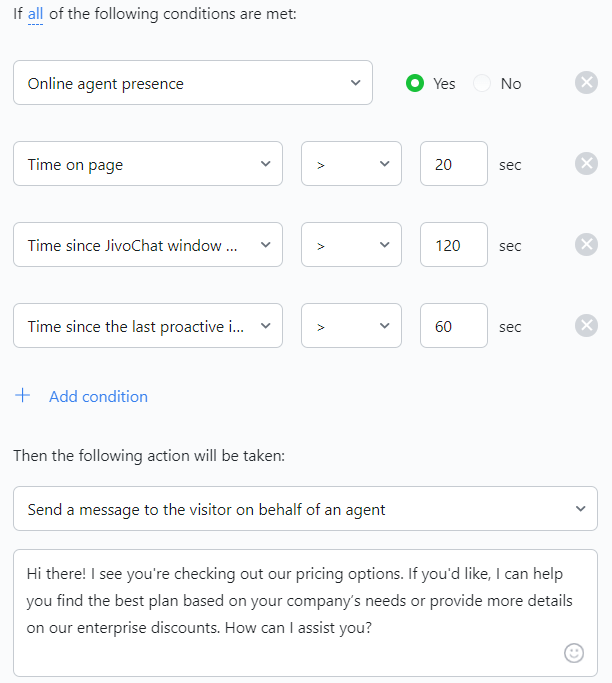
The page is relatively short and pricing models are simple, therefore, we are triggering the invitation relatively fast (after 20 seconds on page), while customizing the message for better response rate.
Offering Incentives (And Not Only Discounts)
A well-timed special offer of any possible kind can be the nudge a hesitant visitor needs to convert. Here’s a pro tip: Use the live chat to offer these incentives in a personalized way, as it makes them feel valued. For example, if a visitor is browsing the features page of a Docker containers backup solution, the message can sound like:
“Hi [Visitor Name], I noticed you’ve been exploring our advanced Docker backup features. Since this plugin has been released quite recently, I’d like to offer you an exclusive opportunity to participate in our early adopter program. Let me know if you’re interested!”
Not only a discount can give the visitor a sense of value; by this early adoption program it is possible to generate leads that would not convert on the website in any other way through the whitepaper or trial.
Route Chats to Specified Departments
As nobody is the jack of all trades, properly routing chats to the right department or specialist makes sure that visitors receive the best possible assistance. When they get specialized assistance from professionals, they are more likely to close the deal. The most obvious example for the IT industry is a current customer that requests support through the website chat instead of the ticketing system or the customer portal. Onboarding the customer success department into the chat tool and subsequent chat routing is an excellent option to improve customer satisfaction.
Create Engaging Welcome Messages
Your initial chat message should be friendly and inviting. It could be a simple greeting or a question that encourages visitors to respond. Pre-chat buttons also help to increase the engagement rate:
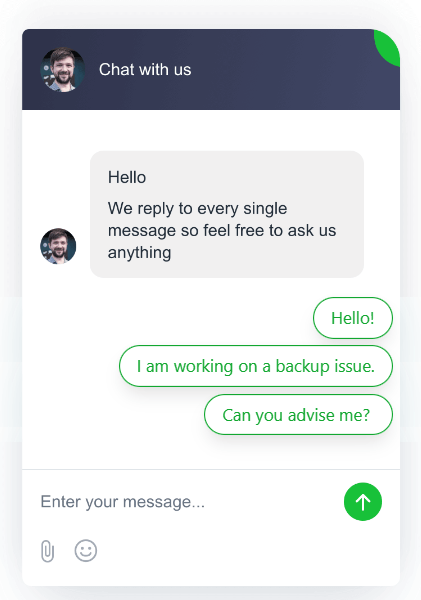
Enhancing User Experience With Email Triggers
Even if the lead has not made the purchase, it doesn’t mean that the sales funnel has ended. You can still follow up on the chat interaction by getting help from personalized emails and keeping the conversation going. These emails will act as a tool of conversion as they keep reminding the person to complete their purchase journey. If the sales department is multi-layered, then the follow-up email from the sales manager after the chat conversation with an inside sales manager can look like:
Subject: “[Visitor Name], still considering a backup solution?”
Email Body:
“Hi [Visitor Name],
It was great chatting with you earlier about our backup solution. I noticed you were interested in our enterprise-level features but haven’t made a decision yet. To help you move forward, I’m suggesting you a free proof-of-concept project for 2 weeks. This will ensure our product fits perfectly in your IT environment. Will you be interested in launching this PoC?
Best regards,
[Your Name]”
Targeting Abandoners
As per the study conducted by Baymard Institute, the average rate of cart abandonment is 70.19%. This means you are losing 70.19% of your high-buying intent customers. This is where you should use the live chat option, which allows you to quickly send them a message to address any last-minute concerns. You can also offer incentives to recover your potentially lost sale at this moment. This is particularly useful for the consumer software and SaaS during the payment stage of the funnel. Having a chat rep viewing what’s happening on the payment pages at any given moment and even setting up the automated pro-active invitation (which is shown after minimum of 30 seconds without activity on the page) on payment pages will prevent you from losing orders.
Utilizing Chat Ratings and Feedback
Give keen attention to the ratings and feedback on the experience of live chat. This will help you refine your live chat strategy, through which you can eventually improve lead generation outcomes.
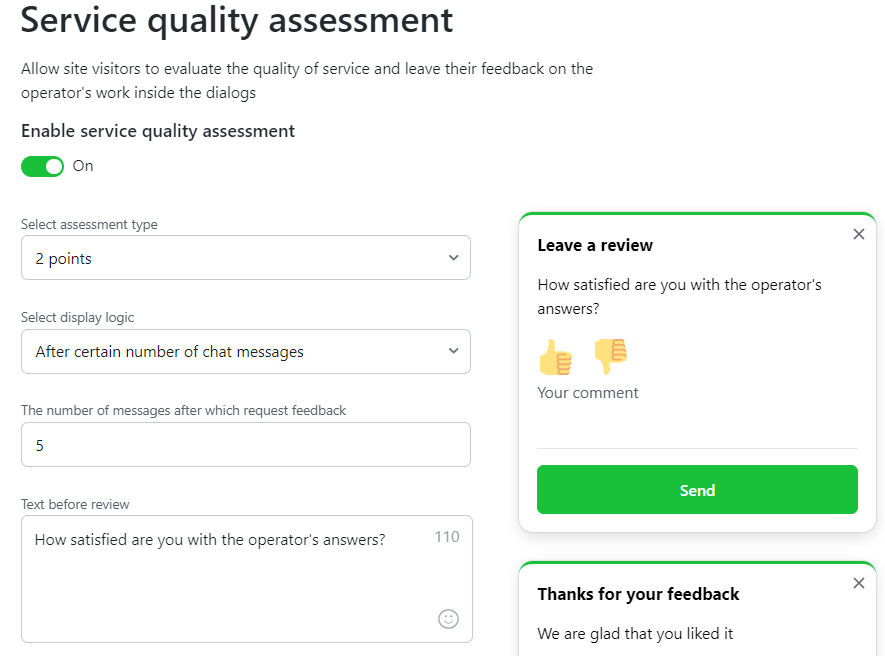
This is applicable for all the industries and the tech sector is not an exception.
Qualifying Leads Efficiently
Not every chat converts into a sale, but you can qualify the high-value leads through live chats. It helps prioritize those that are most likely to convert so that your sales team can focus especially on high-value prospects. To be more specific, let’s compare two example chat transcripts:
Chat 1
Visitor: “Hi, I’m looking for a backup solution for my company.”
Response: “Hi [Visitor Name], I’d be happy to help! Could you share a bit more about your company size and the type of data you’re looking to back up? Are you managing over 100 machines or focusing on specific environments like VMware or cloud infrastructure?”
Chat 2
Visitor: “We have around 500 machines, mostly running on VMware and some on AWS.”
**Response**: “Great! Based on your setup, you’d benefit from our enterprise backup solution designed for large-scale VMware and cloud environments. I’ll pass your information to our sales team so they can provide a customized demo and pricing plan. Is that okay with you?”
The second conversation quickly qualifies the lead as enterprise-level. It helps to prioritize the follow-up with a potential high-value customer.
Setting Up Proactive Chat Triggers
Let me tell you an interesting fact: 33% of the proactive triggers receive responses. So, instead of waiting for visitors to initiate a chat, consider proactively engaging them. You can set up automated chat invitations triggered by specific user actions, such as spending a certain amount of time on a page or visiting a certain website section.
Don’t overload your visitors with proactive invitations, set the corresponding parameter to 60 seconds since the last invitation, like in this example on the screenshot. I found out by experimenting that 20 seconds on a page is enough, and you can open the proactive invitation chat window right after, without bothering anyone.
Place Live Chat Widget Wisely
Ensure that your live chat widget is prominently displayed on your website, preferably on all its pages (or only selected pages, but those where visitors are likely to have sales-related questions). Make sure that it’s not hidden by any other design elements and that it doesn’t hide other elements of the website (cookie consent “Agree” button, for example). In addition, always test the chat’s look and feel on mobile devices as this is where problems with usability usually happen.
Implementing Live Chat for Lead Generation: Step-by-Step Guide
Step 1: Choose the Right Platform
In order to implement live chats for the purpose of lead generation, you need to start with selecting the live chat platform. It is only possible to make the most of the platform if you select the right one. So, first, look for the following features that are a must-have in my opinion:
- AI chatbot integration
- CRM and mailing system integrations
- Design and placement customization options
- Geographical routing
- Departments and chat forwarding
- Pro-active invitations
- Quality assessment
- Welcome messages
- Lead forms before and during the chat
Only after ensuring these features are available in your desired chat solution start engaging with the vendor in pricing and deployment discussions.
Step 2: Setup and Customize the Live Chat
After selecting the right live chat platform, you need to customize the interface of live chat window according to your brand identity. This might not seem to be a necessary step to you, but it it is crucial to enhance the user experience and maintain the consistency of your brand. After this step, you need to deploy the chat on the website by adding a HTML code and define where the chat icon will be placed (bottom-right, bottom-left or any other options). Other setup procedures might include onborading colleagues, creating department structure, setting up geographical routing rules or forwarding rules and setting up pro-active chat trigger rules.
Step 3: Integrate With CRM and Marketing Automation Tools
Integrate your live chat software with your CRM and marketing automation systems. This allows you to automatically add chat leads to your sales pipeline and to your email nurturing sequences. A lot of sales opportunities are lost because of this, so make sure your chat transcripts are properly integrated either using built-in integration, webhooks or by Zapier. Do not rely on your sales reps to manually transfer chat leads into your CRM or nurturung systems; this should be fully automated to avoid human error as chats often distract employees.
Step 4: Train Your Team
Being in the seat of a live chat representative requires both skills in selling products and special chat communication skills to engage visitors in the chat and prevent them from leaving the website. This is why top-notch training of your live chat team (consisting of sales, inside sales, or pre-sales, depending on your structure setup) in both regards is crucial. Regular training sessions enable them to effectively handle a variety of queries at a time, increase the conversion rates, and make sure chat conversations don’t interrupt.
Analyzing and Optimizing Live Chat Performance
Track Key Metrics
Someone in your organization, whether it’s a sales or support executive, needs to manage the important associated KPIs: overall chats, chats accepted, chats accepted with no reply, average first-time reply, lost chats, chat transfers, and finished chats. Based on these stats, continuously test different chat messages, timing, and engagement strategies to see what works best for lead generation on your specific website.
Based on these stats, continuously test different chat messages, timing, and engagement strategies to see what works best for lead generation on your specific website.
Use Live Chat Data to Continuously Improve
You must analyse chat transcripts and performance data if you want to refine your approach and improve lead generation outcomes. This will give you comprehensive details of customer behavior and preferences. When you regularly review performance metrics and customer feedback, you can make data-driven improvements to your live chat strategy.
For instance, after analyzing the chat transcripts and performance data over a month, you can discover that many visitors on the pricing or subscriptions page are asking the same type of questions. This might be about hidden fees, trial period duration, the ability to do a PoC project, its cost and other questions. In addition, there can be a high drop-off rate right after these questions are asked.
In this case, you can proactively update the pre-chat message or the chat window heading on the pricing page to say something like “Got questions about pricing, trial periods, or hidden fees? Chat with us now!” This addresses the most common concerns upfront and improves engagement. Simultaneously, your website team could add an FAQ section on the pricing page with this type of information. As a result, the lead quality improves, and more prospects are moving through the sales funnel.
Conclusion
By implementing these best practices and continuously optimizing your live chat approach, you can effectively generate and convert leads using this valuable customer engagement channel. Live chat is more than just a lead-gen tool; it’s a dynamic channel that allows you to bridge the gap between your business and its audience. By providing immediate assistance, personalized engagement, and valuable resources, you can convert website visitors into qualified leads and sales opportunities, fueling your pipeline with high-value deals.
